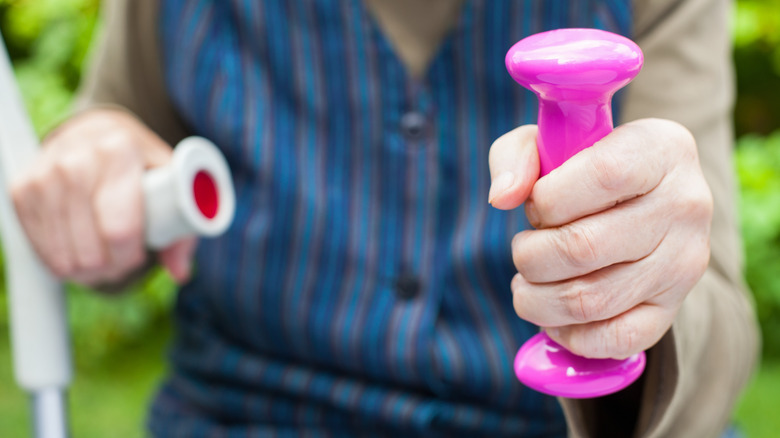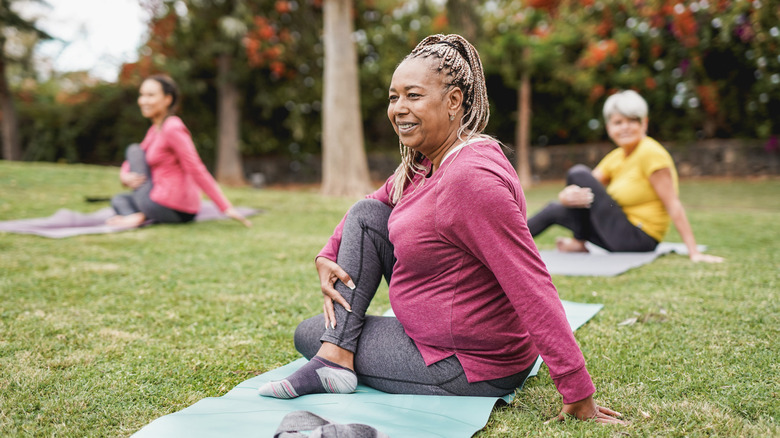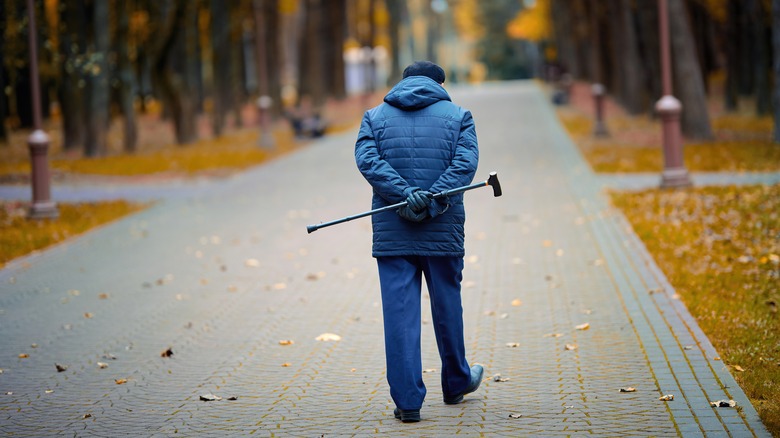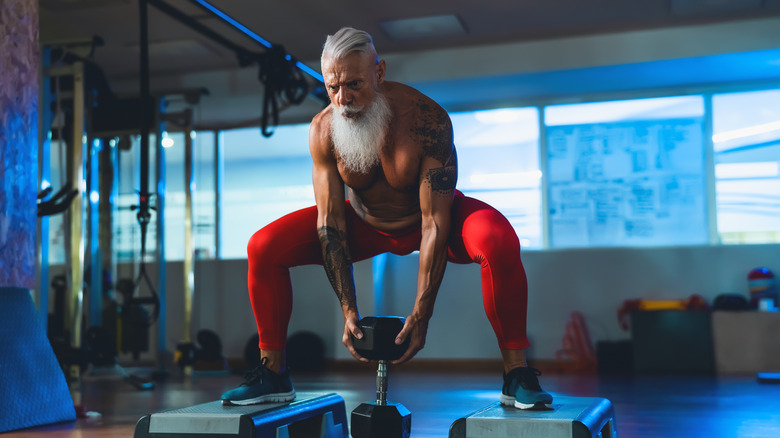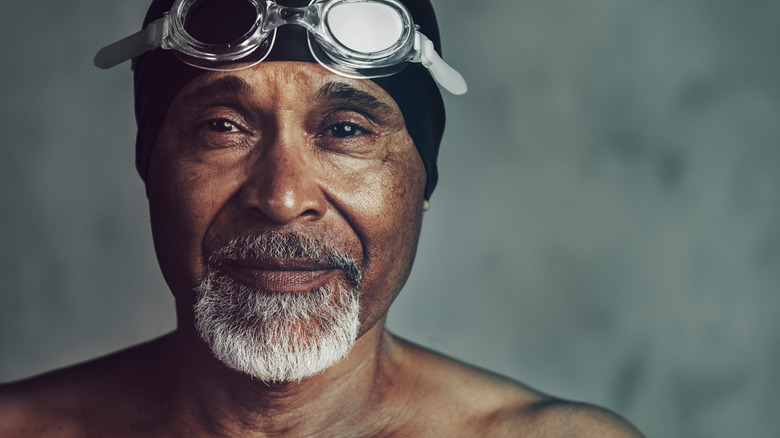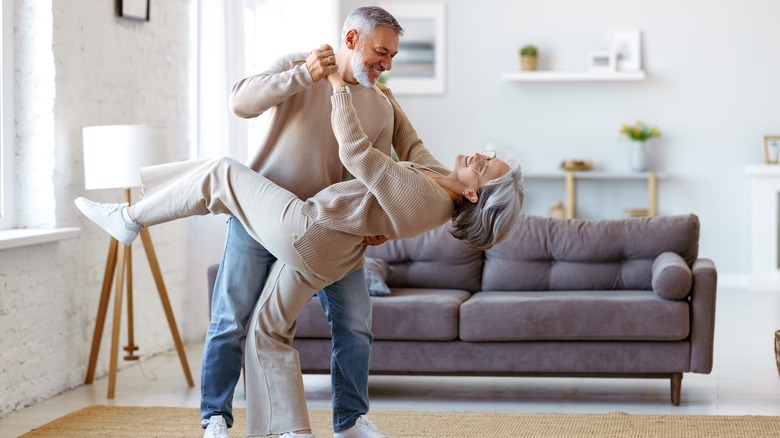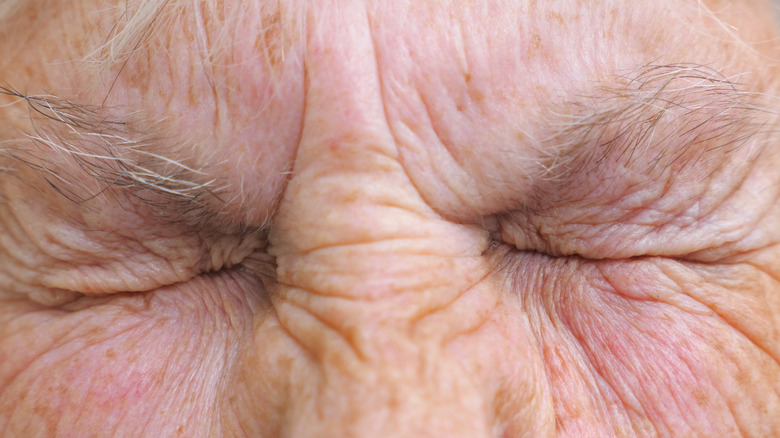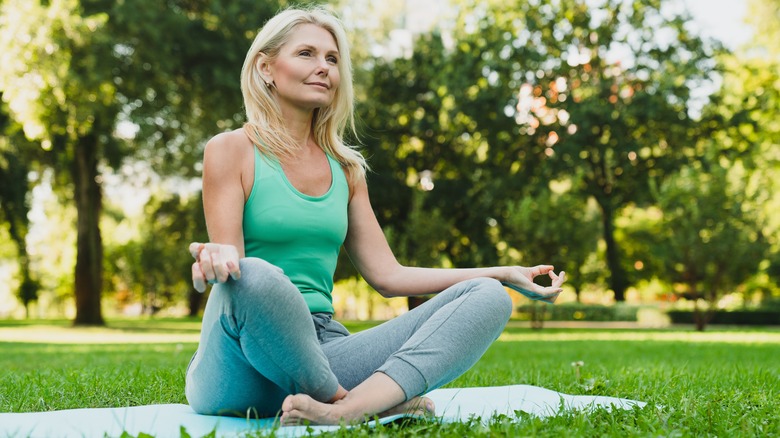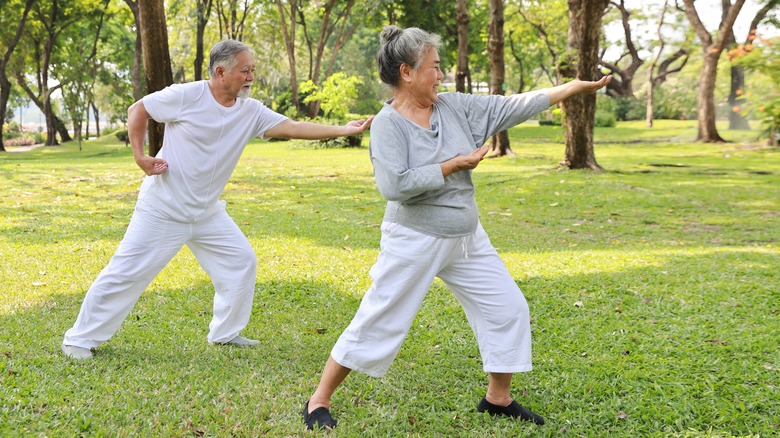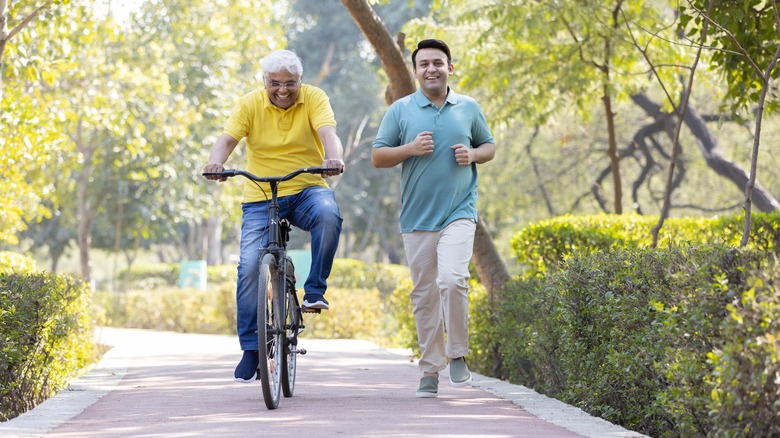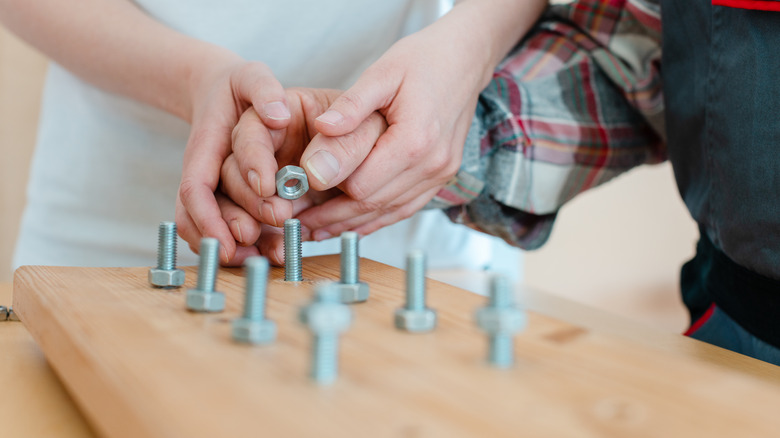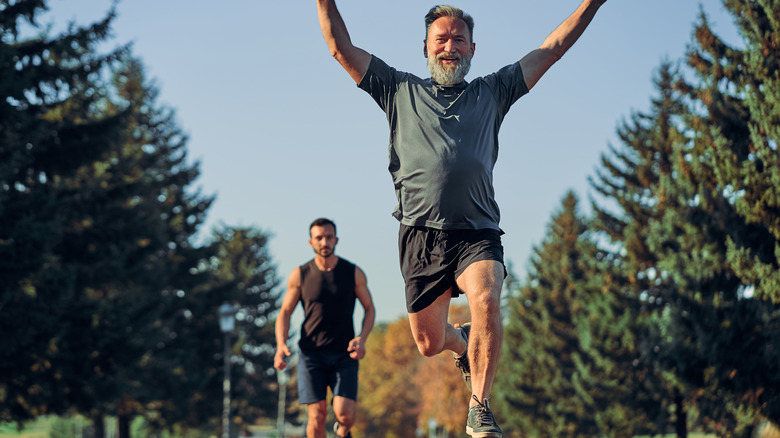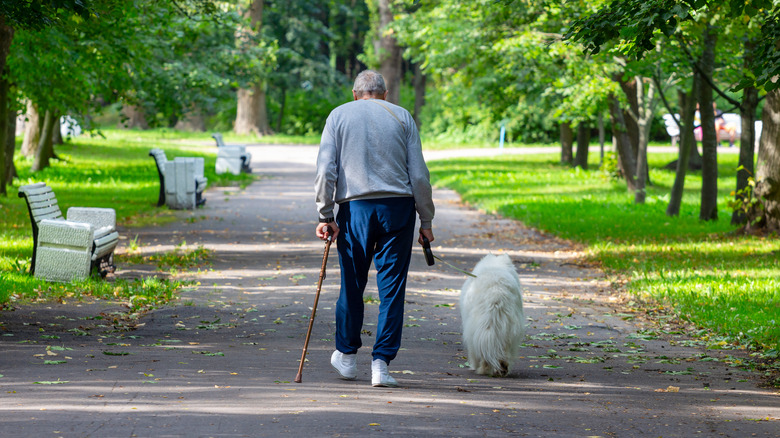The Best Exercises For Parkinson's Disease
Living with Parkinson's can present real challenges. Approximately one in 500 people develops Parkinson's disease, says NHS Inform, with the long-term condition marked by loss of motion and flexibility in the muscles, slower movement, tremors, and balance challenges, as well as mental health-related symptoms like depression and memory loss (per the National Health Service). There is no cure for Parkinson's, which is caused by a decrease in certain nerve cells that results in a lack of dopamine being produced in the brain. Therefore, treatment focuses largely on symptom management and ensuring that the people who live with it have the best quality of life they can.
And given that Parkinson's can have a notable impact on physical health, it's only natural to assume that exercise might have to take a back seat. But in fact, the opposite is true. People who have Parkinson's may find exercise incredibly beneficial, and it's by no means off the table, with a range of physical activities that are not only accessible but could help the management of the condition, according to Parkinson's UK. And above all else, a lot of the exercises that are available to people with Parkinson's are just plain enjoyable to do. Let's take a look at the best exercises for people who have Parkinson's to take part in.
Why is exercise important if you have Parkinson's?
If you have Parkinson's, it's vital to remember that while exercise might seem daunting at times, it has a huge number of benefits. Exercising when you have Parkinson's can assist you in maintaining the standard of life that you're accustomed to, keeping your muscles and cardiovascular system in check, and therefore keeping you mobile, stable, and healthy (per the Parkinson's Foundation). As research published in JAMA Neurology states, taking part in exercise gives people who have Parkinson's a sense of control and ownership over the management of the disease, which is crucial for a long-term condition that individuals live with day in and day out.
All of these benefits add up to big results. As the Parkinson's Outcomes Project found, exercising regularly has the potential to slow the progression for the disease and allow individuals to live a better quality of life for longer (per the Parkinson's Foundation). Trying to achieve roughly two and a half hours of physical activity a week is the optimum for this, although it should be pointed out that there's no one-size-fits-all approach to exercising with Parkinson's. The type of exercise you can take part in, and which will be most beneficial, will depend on your specific symptoms and situation.
Walking may prevent slower movement
It's hard to think of anything better than a good old-fashioned walk. Honestly, getting out into the fresh air, seeing nature, and catching up with friends while you do so? Maybe we're all about the simple things, but that's our idea of bliss. And for people with Parkinson's, a daily walk could be one of the best things you do for your condition. Walking regularly may assist in combatting the incrementally slower movement that occurs with Parkinson's, and keep your stride length long, as it can shorten as the disease progresses (per Johns Hopkins Medicine). The cardiovascular workout that walking can provide can also help your motor coordination and balance.
However, walking doesn't come without its challenges, especially for individuals who may be concerned with freezing mid-walk or a loss of balance (per the Parkinson's Foundation). If this is the case, it might be worth trying certain workarounds. Using a metronome or a steady beat while you walk to may lower your chances of freezing, and taking big, direct steps can also be helpful. Other exercises, like dance or tai chi, may also improve balance, which will then benefit your walking.
If you have tremors, weightlifting can help
Okay, so we can understand why you might not lean toward weightlifting if you have Parkinson's. But trust us when we tell you that it could be one of the most helpful ways to work out with your condition. Not only does resistance training help to keep your muscles toned and healthy, but it may also reduce the severity of tremors, according to research presented to the American Academy of Neurology. When participants in the research did twice-weekly resistance exercises for an hour at a time, they exhibited less noticeable tremors, with results being seen in as little as six months. "Our results suggest that long-term weight training could be considered by patients and doctors as an important component in managing Parkinson's disease," study author Daniel Corcos stated.
If you're weight training, however, safety is essential. Make sure that you begin slowly — you may want to ease in using light weights and fewer reps — and nail down your form first before advancing to the heavier stuff, says the Parkinson's Foundation. If you're working out in a gym, you might find it helpful to write down the exercises you're planning on doing beforehand, so you don't omit any of them. Hydration is essential, too, even when you're not sweating as heavily as you might during a cardio workout, so keep a bottle of water handy.
Swimming is a great full-body workout
Swimming is one of those forms of exercise that we're always looking for more excuses to do. And if you're the same, we hereby give you permission to incorporate it into your regular workout repertoire, as for people with Parkinson's, it's hard to beat. Swimming provides a full-body workout that takes pressure away from your joints, thanks to the no-impact nature of the activity, as physiotherapist Bhanu Ramaswamy says to Parkinson's UK. It can also serve to tone your muscles while simultaneously getting your heart and lungs working.
As with any form of exercise, though, it's useful to take it slow in the beginning, especially if it's been a while since you've got in a pool. You may find it useful to use floatation devices or aids, which may be comforting if you have concerns about your posture making it difficult to swim, or if you experience stiffness. It's always a good idea to let the lifeguard on duty know about your condition, as they can then keep an eye on you while you're in the water. They may also help to get you safely in and out of the pool.
Dancing can help coordination
If all else fails, dance. No, seriously. This isn't just a motto that people can use in their everyday lives, it applies when it comes to exercise, too. If you have Parkinson's and you've tried everything else, dancing might be just the ticket. Dancing as exercise can have numerous benefits for people with Parkinson's, both mental and physical, as research published in Frontiers in Public Health discusses. Dancing, particularly ballroom dancing, was found in a review published in The Arts in Psychotherapy to improve coordination and augment balance. Regular dancing may also provide benefits to individuals who have depression, a psychological symptom of Parkinson's.
So what type of dance is best for you? Luckily, there are loads to choose from. Aside from ballroom dancing, tap dance, ballet, and even seated dance are all viable options, per Parkinson's UK. Having said that, virtually any type of dance that you're comfortable doing with your condition will likely benefit you. So if you wanna throw on an album and simply have a boogie around your room on your own, hey, we salute you!
Facial exercises are important for expressiveness
While exercises that benefit your entire body are incredibly useful for people with Parkinson's, it's also important to get a little more specific. Facial exercises may be highly beneficial for those with Parkinson's to combat facial rigidity and "masking," a loss of expressiveness in the face seen in people with the disease, as the National Institute of Neurological Disorders and Stroke says. Exercising your face may also assist mobility around motor functions like swallowing, and keep your speech clear, says the Cleveland Clinic.
Luckily, too, these exercises are easy to do at home, and often while you're doing another activity. When you're eating, for example, try and exaggerate your chewing, making bigger movements with your jaw and chewing for longer. You can do the same thing while you're speaking, too, opening your mouth wide and being intentionally more expressive with your face. If you're a reader, saying what you're reading out loud can be a good way to keep on top of your speech. And if you thought the days of making faces in the mirror were left in your childhood, now is the perfect time to bring them back, with exaggerated expressions helping to keep your face mobile.
Yoga is especially helpful for posture
No matter what stage of life people are at, from old age down to infancy (Google "baby yoga" if you don't believe us, folks), yoga is a safe and accessible way to exercise. And people who have Parkinson's disease are not exempt from its benefits. If you have the condition, yoga may provide improvements to your posture, stability, and general flexibility, as Medical News Today points out. Yoga may also be instrumental in reducing tremor severity, and as a relaxing, centering form of exercise, it can also alleviate mental symptoms like anxiety and depression that come with Parkinson's.
Specific poses may be especially helpful to combat specific physical traits of Parkinson's, Yoga International suggests. If your posture is becoming more stooped, you may want to incorporate core-strengthening moves, like chair pose or locust variations, into your flow. Knee-to-chest pose can also be a useful move to start with, as it encourages flexibility through your hamstrings, which may be particularly therapeutic for morning stiffness. Some individuals may find full-on yoga practices challenging, and if that's the case, it's wise to modify your poses to make them easier. Using a chair, a wall, or a yoga block can allow you to complete a yoga flow without having to challenge your body too much. Ask your yoga instructor about how you can alter your exercises.
Pain from Parkinson's can be improved with tai chi
On the surface of things, tai chi can seem like a pretty easygoing exercise, but it has some profound benefits. The exercise practice can strengthen your muscles and your immune system, calm your mind, and encourage better flexibility, all in one go (per Women's Health). And for folks with Parkinson's, all of these things could be incredibly helpful for managing your disease. Tai chi could also be useful to manage pain associated with Parkinson's, and may improve your walking function, says Parkinson's UK.
Given that tai chi often incorporates a constant flow of movement into its practice, it's useful to think about how this may impact you if you have Parkinson's, especially if you have any conditions that run alongside it. People who have osteoporosis as well as Parkinson's may find tai chi challenging and should consult with a doctor and an instructor about whether it's the right form of exercise for them (per Parkinson's UK).
Aerobic exercises like cycling provide benefits
If it's been a while since you got your bike out, it's time to dust off the spokes and grease up the chain. For people with Parkinson's, cycling is an excellent way to exercise, thanks largely to the fact that it delivers a comprehensive aerobic workout. Aerobic exercise is particularly important for individuals with Parkinson's disease to do, not only because it keeps your cardiovascular system and function healthy and improves flexibility (per Parkinson's UK), but it also appears to have potent effects on brain function.
A study published in the Annals of Neurology examined the effects of aerobic exercise on the brain, using participants with Parkinson's who took part in stationary bike training three times a week over six months. At the end of the study period, the results looked pretty good. Participants had notably lower brain atrophy, stronger neural connections that led to better motor skills, and better cognitive control when compared to individuals who did different types of exercise for the same period. Not bad, right? And if that wasn't enough, cycling regularly may also improve the gait of people with Parkinson's, according to a further review published in npj Parkinson's Disease, with the review's authors concluding that cycling provided an overall better quality of life.
Mental exercises are essential for cognitive function
Although it's often easy to forget it, exercise isn't just physical. Keeping our minds as well-conditioned and agile as our bodies is vital, especially for people with Parkinson's disease, as the condition can contribute to impaired cognitive function. And mental exercises are a great way to do that, particularly to keep your memory robust, as the Cleveland Clinic states.
Luckily, too, mental exercises generally aren't a chore to do. In fact, you can get a mental workout while playing games with your friends. Board games like chess work your brain by forcing you to think about strategy, and keep your memory sharp through remembering rules, says the American Parkinson Disease Association. Trivia games can have a similar function, while reflex games can help keep your reflexes and coordination sharp. For an exercise that tests your memory, try setting a timer for one minute and name as many colors as you can before the clock runs out (via the Cleveland Clinic). If that's too easy, try doing the same exercise with department stores, car brands, spices, or whatever you like!
Gardening is good for stress
You may not think of gardening as exercise, but honestly, anybody who's ever spent a full day digging, raking, and weeding will know how much it can wear you out (per Costa Farms). Luckily, though, that tiredness is the sign of a great workout, and that could be of huge benefit to people with Parkinson's — and not just physically. Gardening can be a great way to keep your mind active when you have Parkinson's, with brain stimulation occurring when you decide which seeds to plant in which area or what task to focus on next, says the Davis Phinney Foundation for Parkinson's. Gardening is also a natural (excuse the pun) stress buster, a highly significant thing for anyone managing the difficulties that may come with living with the condition.
But we'd be remiss if we didn't mention gardening's physical perks too. When you're gardening, you're constantly working your muscles as you dig, squat, cart around wheelbarrows, and pull up roots. All of this can have a toning benefit to your muscles, and get your heart racing. Additionally, the small, detailed work that gardening requires keeps your hands and fingers moving and your motor skills sharp. So grab your sun hat, and get out into the yard!
Hand exercises help dexterity
People who live with Parkinson's will be well aware of how their hands may be affected by the disease. One of the most common symptoms of Parkinson's is hand tremors, also known as "pill-rolling," which refers to the motion it can cause, says the Parkinson's Foundation. Individuals with Parkinson's may also experience mobility changes, which can occur in the limbs and the hands specifically (per Johns Hopkins Medicine).
One of the best ways to combat this is through performing hand exercises to maintain your motor skills and keep your hands and fingers dexterous, says Parkinson's News Today. Hand exercises needn't be complicated, either. Try simply practicing picking up a small object like a coin or a hairpin using your hands and fingers, putting it down again, and then repeating (per Health Partners). Fingertip touches are also a great way to get your digits moving. Take your hand and hold it outstretched in front of you, with your fingers spread. Then, gently touch the tip of your index finger to your thumb, and return it to the original position. Repeat the motion with your middle finger, ring finger, and pinky before cycling back up through your fingers to the index finger. Repeat as many times as you like.
For mild-to-moderate Parkinson's, sprinting has a range of benefits
The words "Parkinson's" and "sprinting" might not seem like natural bedfellows at first glance, but don't write sprinting off as an exercise just yet. As it turns out, sprinting may be both a beneficial and doable exercise if you have mild-to-moderate Parkinson's disease, as a study published in Clinical Biomechanics states. The study examined the performance of sprinters who had Parkinson's disease versus sprinters who didn't, to determine whether it's a feasible exercise for people with the condition to perform. The authors concluded that not only was it safe and possible for those with Parkinson's to do sprint training, but that Parkinson's didn't seem to meaningfully impact sprinting performance.
This is great news for anyone interested in pursuing or maintaining a sprint training routine, which supplies a wealth of health benefits. Sprinting can help to maintain muscle mass, elevate your athletic performance in other areas of exercise, and crucially boosts your cardiovascular health, as Healthline states. It's vital, however, that you talk to your doctor about whether sprint training is feasible with your condition. And whatever you do, don't forget to warm up: Sprinting puts a serious load on your muscles, so prepare them with a walk or gentle jog beforehand, says certified fitness trainer Emily Fayette via Healthline.
Postural exercises may reduce stooping
One of the most noticeable effects of Parkinson's disease can be on a person's posture. Our brains work to alert our bodies to stay upright via automatic impulse, but when you have Parkinson's, this process can be disrupted, leading to a more stooped posture, says the Parkinson's Foundation. This can be exacerbated by muscles becoming stiff, a common issue for people living with Parkinson's.
One of the best ways to combat this head-on is by focusing on postural exercises, performing them repeatedly throughout the day to remind you to stand upright, says Parkinson Society Canada. A simple way to do this is to perform a check-in whenever you pass a wall. Stand with your back to it and straighten out your posture, connecting your lower back, shoulder blades, and the back of your head with the wall. If you're sitting in a chair you can do a similar action, leaning back into it, connecting your shoulder blades with the chair's back, and holding there for a few seconds before releasing and repeating. It may seem small, but frequent repetitions can create improvements over time and refresh your body's memory for good posture.

